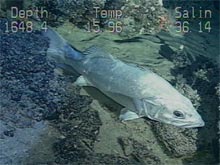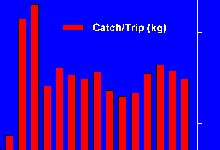
The Charleston Bump rises up from a deep plateau, over 2,000 ft deep, to a depth of about 1,200 ft. Because of its vertical profile, it acts like a very deep reef and attracts many species of marine organisms. In U.S. waters, the large, grouper-like wreckfish (above) is abundant only on the Charleston Bump, which is also the only known wreckfish spawning ground in the western North Atlantic. Click image for larger view.
The Charleston Bump: Managing A Unique Ecosystem
George Sedberry
Principal Investigator
An Important Fish Habitat
The Charleston Bump is an undersea feature that rises up from a deep plateau, over 2,000 ft deep, to a depth of about 1,200 ft. Because of its vertical profile, it acts like a very deep reef and attracts many species of marine organisms, including those that are highly desired as seafood.
In addition to providing deep rocky reef habitat for bottom species such as wreckfish, barrelfish and alfonsins, the Bump causes a change in the flow of the Gulf Stream, the dominant current in the western North Atlantic. The rise in the bottom topography causes the Gulf Stream to speed up and be deflected offshore. This swift meander results in upwelling of cool, nutrient-rich water, and a mixing of cool and warm water along many thermal fronts. Highly migratory pelagic fishes such as swordfish, sailfish, marlins, tunas and oceanic sharks are attracted to these thermal fronts and upwelling zones, because of the accumulation of nutrients and food that occurs there. Many species of fish utilize the Charleston Bump during at least a portion of their lives. Because of this, the Bump is an important fishing ground.

Wreckfish catch per fishing trip has remained steady over the years, following the introduction of regulations in 1990. Since its beginning in the late 1980s, the U.S. wreckfish fishery has been a management success. Click image for larger view.
In addition to being an important fishing ground, the productive waters of the Charleston Bump are believed to be an important nursery area for juveniles of fishery species. Catch data show a high concentration of undersized swordfish that are caught and released in the vicinity of the Charleston Bump. In addition, plankton surveys indicate the presence of very young swordfish, sailfish, tunas and dolphin (mahi mahi) in the waters overlying the Charleston Bump. The young ages of these larval fishes indicate that they were spawned nearby. The presence of many small species of pelagic fish is an indication that the Bump might be an important “nursery ground” where young swordfish and other fishery species begin life.
The Charleston Bump is also habitat for bottom-dwelling fishes such as wreckfish, a large, grouper-like fish that has a global distribution. In the United States, however, it is only abundant on the Charleston Bump, where a hook-and-line fishery -- the only commercial fishery for these species in the United States -- operates. The Charleston Bump is also the only known spawning ground for wreckfish in the western North Atlantic.
Protective Measures
Because of the unique bottom features and the abundance of larval, juvenile and adult fishes of economic value, there has been much consideration given to managing and protecting the Charleston Bump. Currently, fishery resources there are managed by the South Atlantic Fishery Management Council (SAFMC, bottom fish and golden crab) and the Highly Migratory Species Division of the National Marine Fisheries Service (NMFS, swordfish and sharks). As for the wreckfish, the SAFMC has developed a management plan that includes a total allowable catch, individual quotas for each fisherman, restrictions on the kinds of fishing gear that can be used, and closure of the fishery during the spawning season. This management plan has resulted in a small sustained fishery for wreckfish, and a good market and price for fishermen.
The Charleston Bump has historically been an important longline fishing ground for swordfish and other pelagic species such as tuna and dolphin (mahi mahi). Because of the high productivity of the waters in the vicinity of the Bump, juvenile swordfish are often found there. Accidental hooking (bycatch) of undersized swordfish, billfish and turtles raised concerns about the longline fishery operating on the Bump during early spring, when many of these species are migrating northward through the Bump area. For this reason, NMFS closed the Charleston Bump to longline fishing from February through April. This closure has been in place for only two seasons, so its effect on populations of swordfish and bycatch species has not yet been determined.
In terms of future management, NMFS has considered permanent closure of pelagic longline fisheries in the area to help manage highly migratory fishes and to reduce bycatch of marlins, sailfish, sea turtle and other non-commercial species. Although the SAFMC has considered including the Charleston Bump in a series of deepwater marine protected areas (MPAs) to manage deep-reef fishes, the existing management plan for wreckfish appears to be working, and the council is no longer considering the Charleston Bump as an MPA where bottom fishing would be prohibited.
Because of the uniqueness of the Charleston Bump and its importance in the life history of oceanic fishes like swordfish and wreckfish, it has been suggested that the Bump be incorporated into the U.s. National Marine Sanctuaries Program, or that some other type of ecosystem management be employed to protect the area's natural resources. The bottom fishery for wreckfish is already intensively managed, however, and due to the recent seasonal closure of the Bump longline fishery for pelagic species, additional restrictive management may not be needed for finfish species.
























